
Kim Hoffmann
NASM CES (Corrective Exercise Specialist) and Certified Personal Trainer
Our posture deteriorates with age. The older we get, the less we move and we adopt a sedentary lifestyle. Adults are sitting over 9 hours per day while kids 12-19 years of age are now way over that number by being schooled from home. Research shows that a typical office worker spends close to 80% of their waking hours by sitting down.
To counter this, we can improve our posture when sitting, walking and sleeping, as well as introducing daily short exercises for good posture that strengthen our muscles.
Before we get to the tips and exercises, we will start first with what posture actually is and how it affects us.
What is a posture?
Posture is the position our body has when we move, sit, and stand. It is held and supported by our bones, muscles, and tendons. There are two types of posture: static and dynamic.
Static posture is the position we’re in when we stand, sit, or lie still.
Dynamic posture is how we move and how this movement affects our bones, ligaments, and tendons.
The body is a kinetic chain, which means that if one part of our body does not function well it can soon affect another. We could, for instance, start having breathing issues because our shoulders move forward due to desk work, reducing the space for the lungs to fully inflate.
Or we complain of knee pain which, on closer inspection, is because our pelvis is pulled forward putting our femurs in a less-than-ideal position.
What are the different types of posture?
First, we’ll look at healthy posture. For this, our body should be standing up straight with everything aligned from our head to our toes.

Our ears should be in line with our shoulders, our shoulders in line with the middle of our hips, and our hips and knees in line with our ankles.
When we look at the spine from the side, there are normal curvatures which make the spine look like an ‘S’. These curvatures are called lordosis, which is a natural arch of the spine, and kyphosis, a normal rounding of the spine.
With bad posture, these normal curves in the spine are affected.
In the following sections, we can see the different posture types and how the spine and muscles are affected by them:
- Upper-Crossed Syndrome
- Lower-Crossed Syndrome
- Layer Syndrome
- Kendall’s Kyphotic-Lordotic Posture
- Kendall’s Lordotic Posture
- Kendall’s Flat-Back Posture
- Kendall’s Swayback Posture
- Pes Planus Distortion Syndrome
Upper-Crossed Syndrome
Upper-Crossed posture syndrome refers to muscle imbalances seen in the upper body. Characteristics of this postural syndrome may include a forward head, rounded shoulders, and an excessively rounded mid-upper back.
It’s called a crossed syndrome because the muscles that are tight and lengthened resemble a cross. The tight chest muscles pull our shoulders forward. If our back muscles (the lower trapezius and rhomboids) are too weak, they can’t pull our shoulders back.
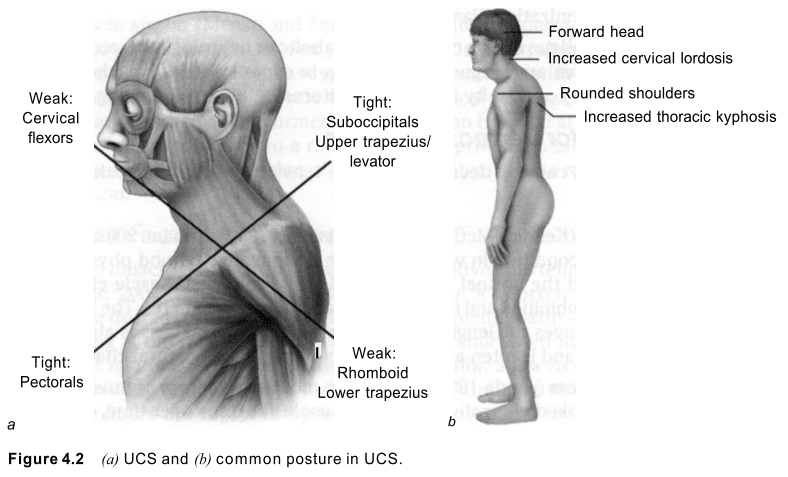
The same happens with our upper back and neck muscles that are too tight and neck flexors that are too weak.
While this syndrome focuses on the upper body, it does affect the lower part as well in that we may see slightly flexed knees and hip joints.
We experience this posture if sitting for long periods of time
When our arms are always forward ready for typing or using the mouse or holding the steering wheel, our shoulders round forward to accommodate.
When we do that, our head moves down to stay in line with the spine. In order to see in front, we lift our head, putting our neck in an extended position. This is why we may get neck and shoulder pain while studying or working for a long time.
Research shows that the benefits of the current guidelines for exercising of 30 minutes per day may be “undone” if we spend the other 15.5 hours in a seated position.
This is not limited to working or studying at our desk, but also includes watching TV and playing video games.[1]
Lower-Crossed Syndrome
This refers to the muscle imbalances in the lower body where we usually see an anterior pelvic tilt. It occurs when our pelvis is being pulled forward, most likely by tight hip muscles, making our back arch more than it should.
Where Upper-Crossed syndrome affects the lower extremities, Lower-Crossed Syndrome affects the upper body.
We may see a slight to extreme lower back arch, but also increased kyphosis and forward head posture.
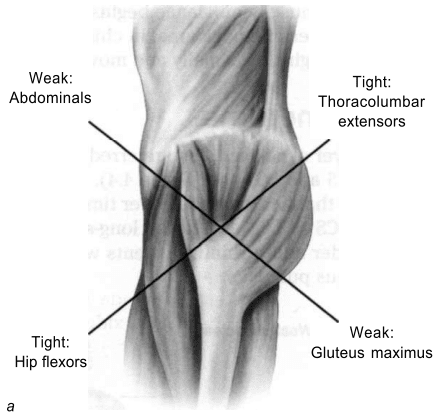
The knees could either be slightly flexed or hyperextended depending on what happens in the pelvic region.
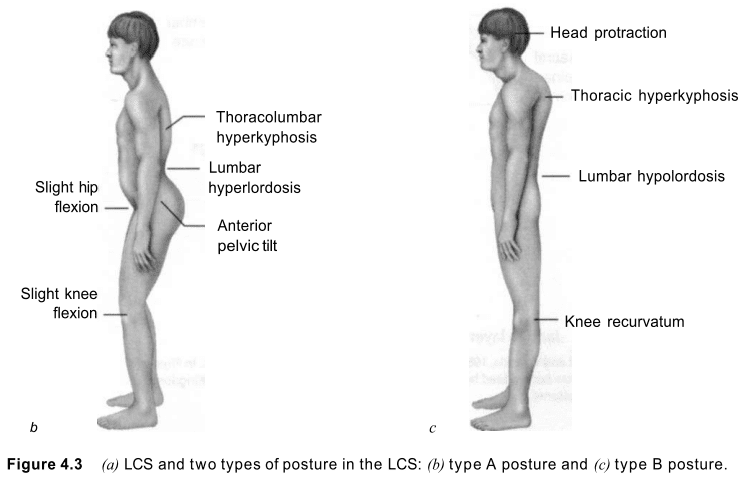
Layer Syndrome
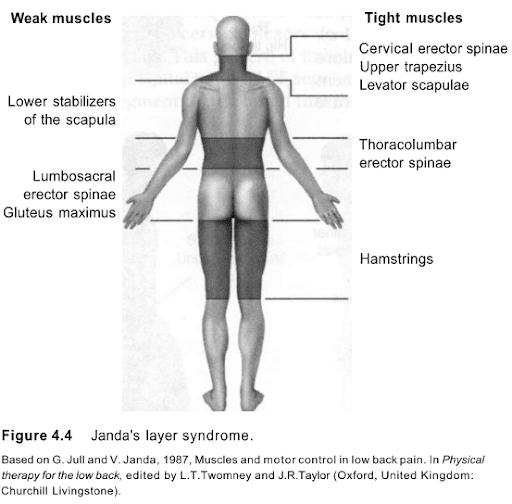
This is the last of Janda’s Postural syndromes and as the name suggests, it can include characteristics of both upper and lower-crossed syndromes.
In this case we may find an anterior pelvic tilt, with forward head posture and rounded shoulders as well as flexed or hyperextended knees.
Kendall’s posture types
There are 4 different Kendall’s postures (image below) and we will discuss each type in more detail.
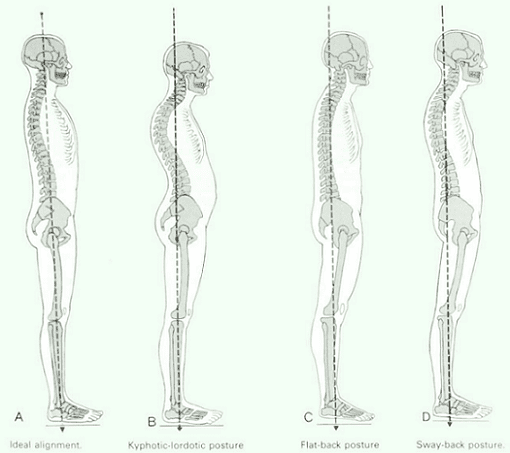
Kendall’s Kyphotic-Lordotic Posture
In this syndrome, both the lower back and mid-upper back curve more than they should. This makes the S-shape much more pronounced, giving an anterior pelvic tilt and rounded shoulders. We also see that the neck is extended due to the rounded shoulders, creating a forward head posture.
Kendall’s Lordotic Posture
The excessive curve in the lumbar spine (lower back) due to this posture type is very pronounced. It occurs when there is a muscle imbalance around the pelvis and hip joint and torso.
This can affect the position of the pelvis which is usually tilted forward. It can also affect the knees, but the upper body is generally unaffected.
Kendall’s Flat Back Posture
In this posture type we find that there is barely any curvature in both the lower and mid-upper back. The arch in the lower back is gone because of a posterior pelvic tilt. This means that the pelvis is now pulled back and there is a rounding of the lower back instead.
The thoracic spine also has no curve, though there might be an excessive kyphosis in the upper thoracic spine and shoulders. We may also find that the head has slightly moved forward and that the knees are hyperextended.
Kendall’s Swayback Posture
This postural syndrome is like the layered-crossed syndrome in that there are issues in both the upper and lower part of the body.
We may see excessive kyphosis in the thoracic spine, but also a posterior pelvic tilt which decreases the arch in the lower back. The head may move forward causing the neck to extend and rounding the shoulders.
Pes Planus Distortion
The last of the postural impairment syndromes is called Pes Planus Distortion Syndrome. This is also known as Flat Feet.
When the feet cave in, they flatten, which causes the knees to move closer together, which then causes the hips to rotate inwards and thus tilting the pelvis forward.
In other words, flat feet can have profound effects on the body all the way from the big toe to the lumbar spine.
What is Postural Syndrome?
Postural Syndrome is a condition that is caused by having bad posture for extended periods of time. It affects the whole back, neck, and shoulders.
It can happen in any position but it is especially common when sitting. Because of the overwhelming amount of sitting we do each day, it is very tempting to take up the same position and so when we work, drive or use our phones, we have the same posture.
When we slouch, we bend the lower back forward. If we do this for a prolonged time, it places a lot of stress on the joints.
Symptoms start once we’ve had bad posture for a while
Most people find that the pain is usually worse at the end of the day and they may feel a dull ache in the lower back region or tense shoulder and neck muscles.
What causes bad posture?
Bad posture is usually caused by being in the same position for a long time. The most common example is sitting at a desk.
RELATED — Bad posture can impact your health: Getting it straight
What happens is that some muscles become very tense because they are always used. Others become very weak because we never use them. This can create those muscle imbalances and can eventually affect the shape of our spine and the strength of our tendons and ligaments.
These are some activities and states which may contribute to bad posture:
- Phone use
- Wearing high heels
- Injury
- Obesity/increased body weight
- Long periods of being inactive
- Slouching
- Slumping over a desk
- Soft mattresses
- Sleeping positions
- Wrong types of pillow
- Carrying habits
- Repetitive movements
Phone use and posture
Text neck is a condition in which people have forward head posture and rounded shoulders and upper back. One of the reasons this is becoming more and more common is phone use.
RELATED — Exercise Guide to Boulder Shoulders
Most people look down at their phones rather than holding it up to their eyes, which is the best position for our neck.
When our head is upright, it’ll weigh about 10-12 pounds or 5 kilos. The further we look down, the heavier our head will be. This puts enormous stress on our neck vertebrae and muscles.
A lot of children and teenagers are seen with this postural type as they can spend a lot of time on their phone or playing video games. When this happens continuously for a long time it can lead to spinal remodelling which means the abnormal shape of the spine, such as the excessively rounded shoulders and upper back, will become normal.

Impact of wearing high heels on posture
When a person wears high heels, they put their ankles in what’s called plantar flexion. This means that they are pointing their toes while walking. This puts a lot of extra pressure on the forefoot and it contracts the Achilles tendon and calf muscles even when at rest. Over time, the muscles can lose strength.
Wearing high heels changes the position of the pelvis
This also affects the position of the femur which in turn increases pressure on the front of the knee.
Lastly, the centre of gravity moves forward when wearing heels. In order to put it back, we’ll need to arch our back more to stand upright which puts stress on our lumbar discs, causing pain.
To decrease the risk of pain, we can lower our heels, only wear them for short walking distances, or stretch out calf muscles regularly. For more information, see The Painful Reality of high heels.
RELATED — How to stretch to stay flexible (with examples and instructions)
How injury can impact posture
Injury can affect posture in many ways because it changes the tissue around the injured area. Muscles will start tensing, which is called a spasm, trying to protect this area and keep it stable.
When this happens for a short time, it will prevent further injuries in this area, but prolonged muscle spasms will limit movement and can lead to weakened muscles over time.
This results in an imbalance between the muscles that try to protect the injury and the muscles functioning normally. This can lead to postural changes.
Relation between obesity and posture
Weight gain can affect posture because our body needs to put itself in a different position to be able to deal with the weight. Possible effects include a misalignment of the spine, a change in centre of gravity, or more stress on joints.
RELATED — A Guide to Mindful Eating
Additional weight puts added stress on the spine in places it shouldn’t. This can then affect our pelvis and hips. Another consequence is that when our belly starts protruding, our centre of gravity changes.
Proper alignment of the spine is difficult with extra weight
To compensate, our body will naturally arch the lower back and tilt the pelvis forward to bring that centre of gravity back in the right position. This changes the position of the femur to compensate for the change which then affects the hips and knees. This can also happen during pregnancy.
Long periods of inactivity and impact on posture
While inactivity can pose a great risk for any kind of illness or disease, it also affects posture. Muscles lose their strength over long periods of not using them. This goes not only for the muscles we can see, but also the muscles that hold us upright. When we lose our strength in one muscle, another will need to step up to take over its job, leading to underactive and overactive muscles.
RELATED — Hoffmann’s Hacks: Make exercise a part of your daily routine
Slouching, spine and posture
When we slouch, we put our spine in a position it was not made for. Our neck will get more strain as our head bends forwards putting extra pressure on the neck.
The lumbar spine will round more than it should and carry the weight of the upper body in a suboptimal position. This affects muscles, tendons and ligaments.
The extra strain on these tissues will gradually pull our vertebrae out of alignment. Misalignment of the spine can lead to nerve irritation and joint pain as vertebrae press on tissues or nerves and prevent the body from functioning well.
Slumping over a desk
Slumping is another way to create tension and pain in the spine. It is essentially the same as slouching. Our head will bend forward, creating tension in the neck, our mid-upper back will round even more and our lower back will start rounding due to a posteriorly tilted pelvis.
When we slouch we are reversing the curves of the S-shape of the spine
Sleeping on a soft mattress can affect posture
The clearest sign that we sleep on a mattress that is too soft is when we wake up with a sore and stiff lower back. A soft mattress gives in to the weight of the body.
In general, this means that the heavier we are, the more we dip when we sit or lie down. Depending on whether we sleep on our stomach, side or back, this can wreak havoc on our spine.
If, for example, we like sleeping on our side but our mattress is too soft, we will sink in and bend our spine sideways. It will also put a lot of pressure on our hips and shoulders. Over time, this will create other problems including interrupted sleep, pain and stiffness.
RELATED — Sleep apnea: How to cure it and get your sleep back
It’s important to rotate or flip the mattress regularly, because the mattress will form to the shape and weight of our body and will no longer provide adequate support.
Sleeping position and posture
The way we sleep will also affect our posture and quality of sleep. It goes together with a good and supportive mattress and pillow.
Back sleepers will generally have the best support because they spread their weight evenly across the mattress. This means that there is no pressure on specific areas on the body.
If we sleep on our stomach however, this could place extra stress on the lumbar spine and pelvis. If the mattress is too soft, our hips will sink in, putting our lower back in an uncomfortable position.
Pillow is important for posture
Another thing to consider for a good night’s sleep is the type of pillow to best support our head and neck. It depends on how we sleep, but if our pillow is too soft and we sleep on our side, our head will sink into the pillow extending our neck sideways. This will cause stiffness in the morning.
If we sleep on our belly and use a firm pillow, it will push our head back because there is no give, so we’re hyperextending our neck.
Carrying habits
Lots of people, including children, tend to carry a handbag, backpack, or an attaché case over one shoulder. This creates an imbalance in the spine as we often have to compensate for the weight of that bag. The long-term consequence of this is that we may end up with one shoulder higher than the other.
Repetitive movements
When we have a job or hobby that requires performing the same movements repeatedly, we run the risk of overworking those muscles.
Examples or people susceptible to this are painters, carpenters, golfers, and baseball pitchers.
People in these professions or sports use their dominant arm frequently and this can cause muscular imbalance.
How can I improve my posture?
The fact that so many aspects of life directly or indirectly affect our posture is no reason to panic. There are many reasons that someone is not as active as they want to be and we can’t just change our job because we sit too much.
There are some things we can do, however!
Tips for improving our posture when sitting
Let’s look at some things we can do while sitting at our desk.
- Make sure your feet are flat and touch the floor. This puts your calf muscles in a position where they don’t contract. If you’re wearing heels, an elevated footrest gives good support. You could also take off your shoes.
- Try not to cross your legs as this influences the muscles that tense and lengthen. When you always cross your legs the same way, some muscles will become overactive and others underactive. If you want to cross your legs, change sides every so often.
- To choose the right height of your chair, make sure that your knees are at the same level as your hips. This puts joints and muscles in an optimal position without compensation.
- The back should be supported by a good desk chair. Choose one that supports the lumbar spine and sit all the way back against it.
- Elbows should be close to the body and supported, keeping them parallel to the floor. Ideally, you’d want to have them on the desk rather than armrests as this can tempt you to lean to one side, which can then create an imbalance in musculature.
- Try to keep your shoulders relaxed. Women, especially, tend to breathe upwards which can create tension in the neck and shoulders. If this is you, you’ll need to pay extra attention to your shoulders and consciously relax them.
- Lastly, you’ll want the monitor at eye level to keep your neck in proper alignment. When the monitor is too low or too high, we put extra pressure on our neck by bending our head.
Once you have everything set up in an optimal position, the next best thing you can do is to go for a walk and stretch.
Tips for improving our posture when standing and walking
To look after our posture when standing and/or walking, we’ll want to make sure that our head is level, our shoulders are rolled back, and we stand up straight.
A good way to remember to stand up straight is to puff out our chest. We can’t do this while hunched over.
Pull in your stomach and place the majority of your weight on the balls of your feet.
Tips for improving our posture when lying down
We can also look after our posture while lying down. We’ll need to consider the type of mattress and pillow we have and how we sleep.
The type of mattress you need will depend on your body type and size. An overweight person will need a different mattress than a jockey.
When we’re overweight, a soft mattress will make us sink in further, making it harder for us to get out of bed, whereas a slim person might prefer a soft mattress as a firm one can make it feel like they’re sleeping on the floor.
A good pillow means a good night’s sleep and a proper spine alignment
Sleeping on our stomach will mean we need a pillow with a different thickness than someone who sleeps on their side. For people who sleep on their side, there will be a different option depending on how broad your shoulders are.
Have a look at this Sleepyhead sleep guide for more information on the right type of pillow for you.
The best position to sleep in is on our back. This way we distribute the weight evenly and so there is no stress or pressure on our body.
Sleeping on our side is the next best position, as long as we put a pillow between our legs or knees. Lots of people will want one leg in front of the other to be more comfortable, but this puts our pelvis and hips at an odd angle. Keeping a pillow between our legs will keep them level.
Sleeping on our stomach is the least preferred option, because it is difficult to keep our spine and neck in proper alignment.
If this is the only way you can sleep, consider putting a pillow under your chest or hips to reduce the strain on your back.
Exercises for Good Posture
Once we have everything set up at work and in bed, there are still a few things we can do to look after our body and posture. These are stretches and exercises to stimulate the muscles and release any tension that may have built up. You can do these at your desk.
Shoulder blade squeeze
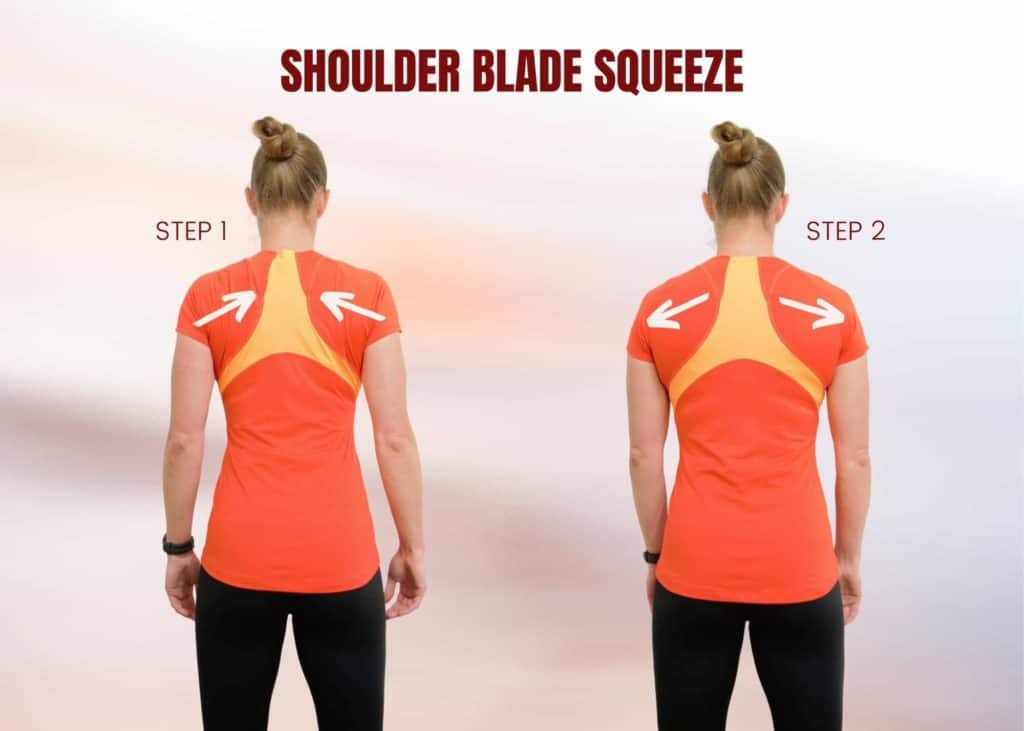
For this exercise you can sit or stand. Make sure your back is straight and you’re looking straight ahead. Bring your shoulder blades together and squeeze the muscles in between. Hold the squeeze for 5 seconds, then relax. Do this 5-10 times.
Reverse high five

Assume the same position as in the previous exercise and keep your hands by your side with your arms straight. If you have armrests, put your arms on the outside. Push your hands backwards. You’ll feel your chest open and your back muscles contract. Do this 10 times.
Chest opener
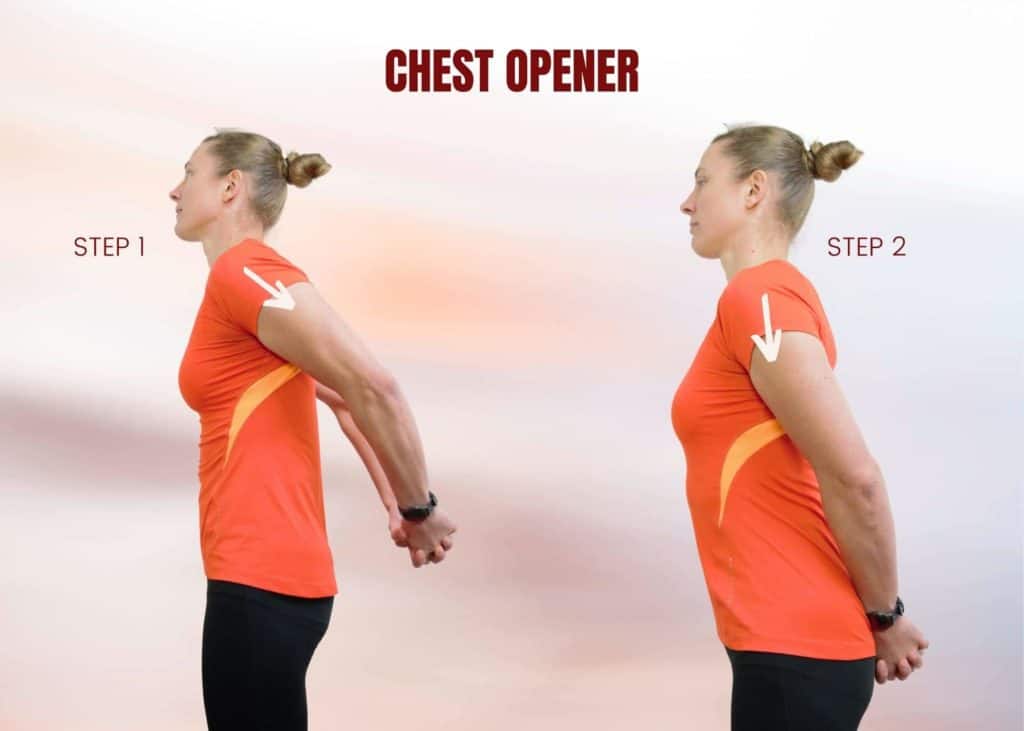
You’ll want to do this one standing. Clasp your hands behind your back and push your shoulders down towards the floor. Move your hands away from your body. You should feel your chest open. Hold for 5 breaths and then release. Do this 5-10 times.
Armpit opener
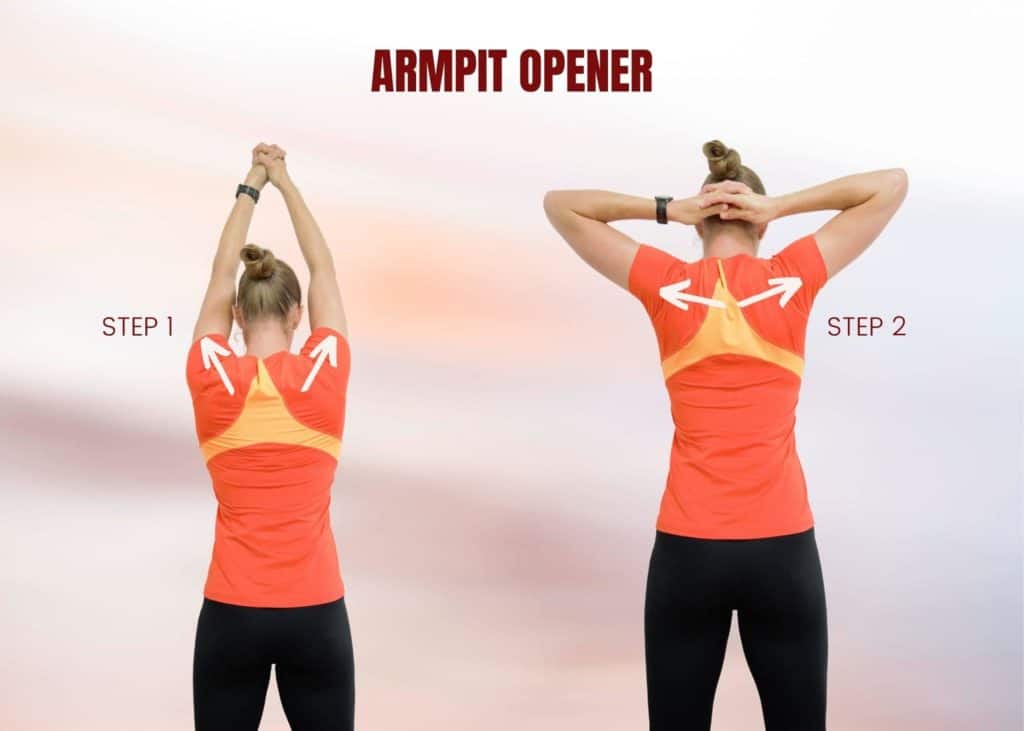
Another stretch for the chest is the armpit opener. For this one, reach the arms out to the sides and up and overhead, clasping the hands at the top. Stretch the arms up, and then bend the elbows towards the back of the room to stretch the chest and armpits. Hold for a breath, and then straighten the arms back up. Repeat 10 times.
Chin tucks

This one is for the neck muscles. It’s prescribed for people that have neck pain or forward head posture. What you do is poke your chin out and then bring it back as far as you can into your neck. You’ll resemble a chicken picking up seeds, albeit at a slower pace. Do this 10 times.
Goalpost squeeze

This is a stretch to open up your chest and strengthen the back muscles. Lift your arms up with your elbows bent at 90 degrees and at the same level as your shoulders. Relax your shoulders and then pull the elbows back.
Imagine that you’re squeezing a hundred-dollar bill in between your shoulder blades as you work the upper back. Release and then repeat. Do this 10 times.
Wall angel

This is a great exercise for activating the postural muscles of your back. Stand against a wall and put your feet about 10-20 centimetres away. Make sure to keep your pelvis, shoulders, and head touching the wall.
To begin, put the back of your hands against the wall as though you’re surrendering. Your elbows can be lower than your shoulders. Keep your hands against the wall as you slide them overhead. Go only as far as you can without arching your back or lifting your hands off the wall. Do this 5-10 times.
Mini Cobra

Lie on your belly and put your hands under your shoulders. Activate your glutes and bring your belly button into your spine. Push your upper body off the floor and lift your hands and squeeze your shoulder blades together.
You’ll want to keep your head in line with your spine, so in the starting position you should be looking at the floor. When you push up, your head should follow. Do this 10 times with a pause at the top.
Reverse plank bridge
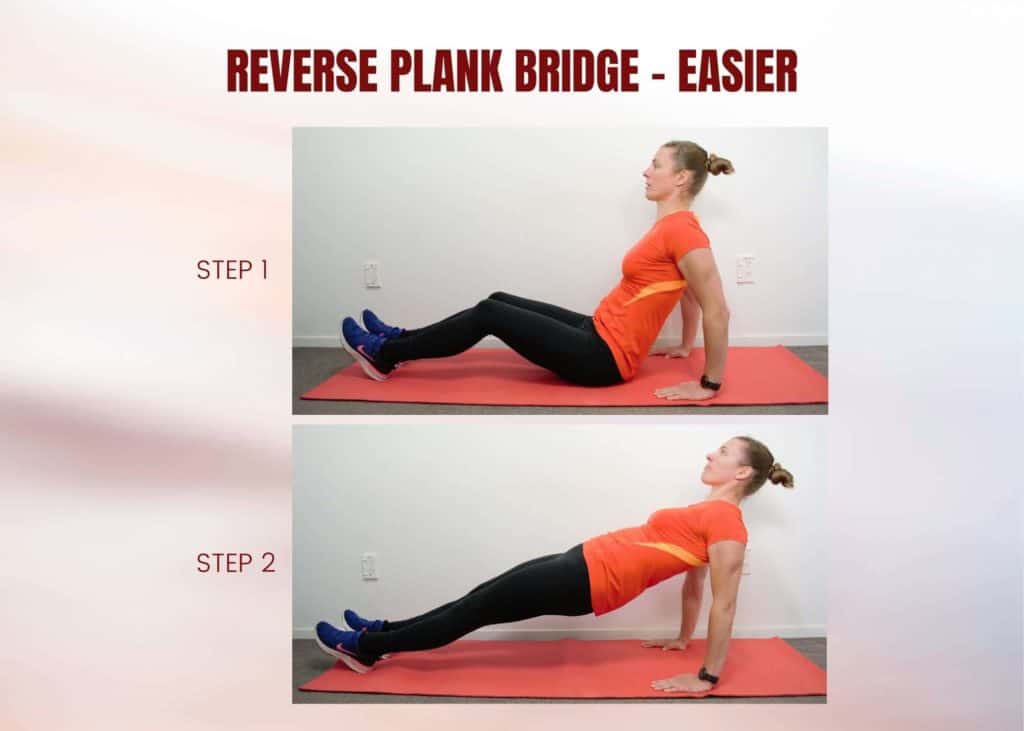
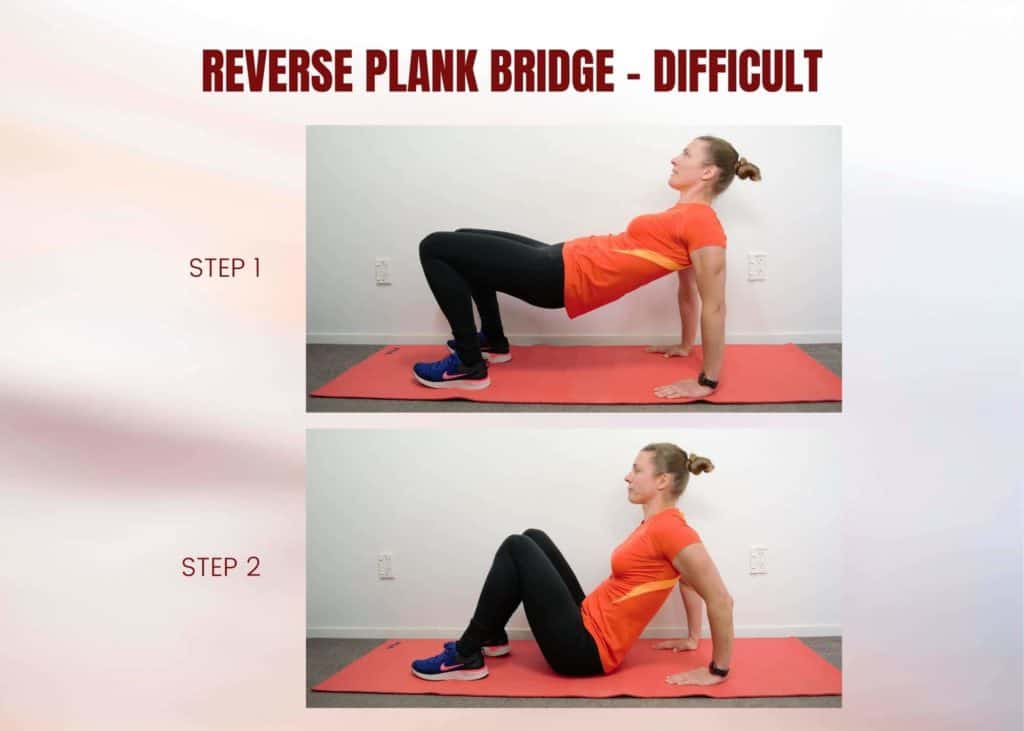
For this exercise we start by sitting down and placing our hands on the floor with the fingers facing the body. Feet go either flat on the floor or on the heels. You then push your body off the floor by lifting your hips.
If your feet are flat on the floor, try to get your hips at the same level as your knees. If you have your heels on the floor, try to keep your body as you would in a normal plank or push-up position, keeping your shoulders, hips, knees, and feet in one line. This version is slightly easier. This exercise works the abs, glutes, hamstrings and shoulders.
This exercise, perhaps, might be too hard for beginners as it puts pressure on the shoulders. If you’ve got good shoulder mobility you should be fine. If the reverse plank is too hard, try the glute bridge instead.
Glute bridge with leg kick
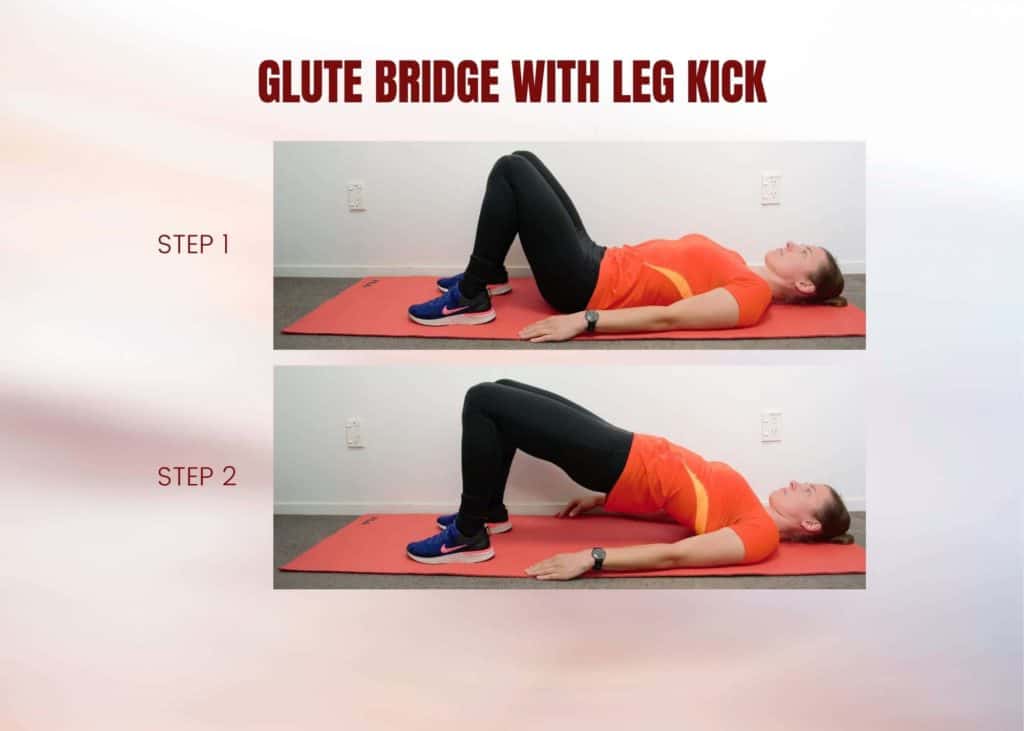
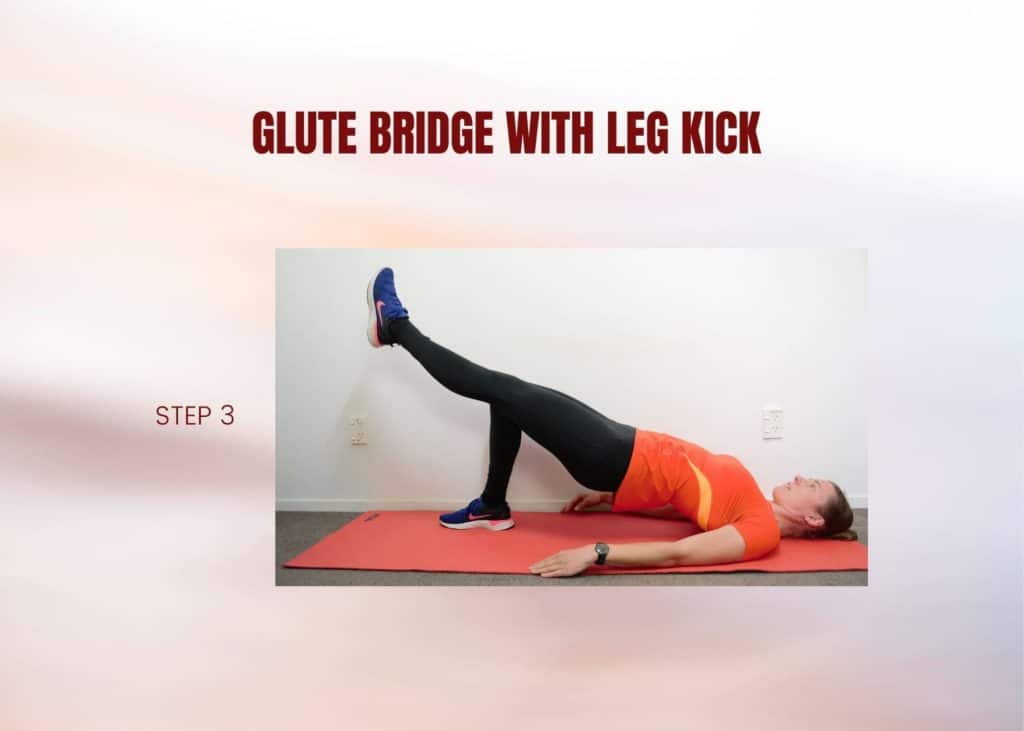
Lie down on your back with your knees bent and feet flat on the floor. Bring your feet as close to your hips as possible. Push your hips up towards the ceiling and squeeze your glutes. Now lift one foot, keeping your knees together. This will activate your abs. Hold for 20-30 seconds, then swap. Do this 5-10 times.
Plank

Lie down on your belly and plant the balls of your feet on the floor. Put your elbows down and keep your hands relaxed in front of you. Push your body off the floor, so your knees, hips, and back all line up.
Tilt your pelvis back for extra activation of your abs and glutes and to keep your lower back protected.
Related Questions
1. Can posture affect mental health?
Yes, research shows that it can positively and negatively impact our mental health, depending on how we sit or stand. See Amy Cuddy’s “Your body language shapes who you are”.[2]
She explains that taking a Wonder Woman-like stance can make us feel more confident. Or read a study by Elizabeth Broadbent: “It suggests that sitting upright can make us feel more alert and enthusiastic, less fearful, and have higher self-esteem after a stressful task.”[3,4]
2. Should I use a posture adjuster?
The short answer is – discuss this with your physio. Remember that an adjuster is a brief fix that gives us cues to straighten up.
However once we take it off, it is easy to resume our usual posture. Doing the exercises will improve our posture, because we’re constantly stimulating our muscles.
3. How long should I wear a posture corrector/adjuster per day?
Your body will need to adapt to an adjuster.
Most experts agree to start easy and advise patients to begin with a corrector for 15 to 30 minutes a day for 3 or 4 days a week, slowly increasing the days. Introducing too much stimulus can lead to severe soreness and pain.
If you can’t wait and would like to know when the next article in the series will be coming out, you can join our healthy community and Subscribe to our Newsletter. It’s free. Also, please check other articles on Health and Wellness.
Kim Hoffmann is a certified Personal Trainer and Corrective Exercise Specialist based in Auckland. She also specialises in women’s health and fitness by taking into consideration the menstrual cycle and hormones and implementing them in different workout plans. The workout methods and routines include free weights, suspension straps and boxing, as well as strength training and high intensity.
Kim’s passion is helping people move better and improve their quality of life. She helps men and women of all ages achieve their goals and also offers online classes and consultations. You can see more of Kim at Snatch Fitness.
References
(1) Hamilton M., Healy G.N., Dunstan D.W., Zderic T.W., and Owen N. (2012). Too Little Exercise and Too Much Sitting: Inactivity Physiology and the Need for New Recommendations on Sedentary Behavior. https://www.ncbi.nlm.nih.gov/pmc/articles/PMC3419586/
(2) Cuddy, A. (2012). Your Body Language May Shape Who You Are. https://www.ted.com/talks/amy_cuddy_your_body_language_may_shape_who_you_are?language=en#t-1232826
(3) Wasmer Andrews L. (2017). Good Posture May Ease Symptoms of Depression. https://www.psychologytoday.com/nz/blog/minding-the-body/201701/good-posture-may-ease-symptoms-depression
(4) Nair S., Sagar M., Sollers J 3rd., Consedine N., Broadbent E. (2015). Do slumped and upright postures affect stress responses? A randomized trial. https://pubmed.ncbi.nlm.nih.gov/25222091/






